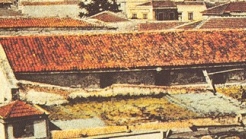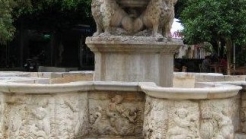

Greece
The Fortezza (Fortezza) is the Venetian castle in Rethymno, which dominates the hill of Palaiokastrou, almost into the center of the old town. The Fortezza is visible from every corner of the city, while at the same time has panoramic views across the town of Rethymno and the west coast, hiding within the entire centuries.
The role in Venetian Rethymno
But immediately after the end of the work it was found that the remaining inside the Fortezza building private dwellings was minimal, so the fortress was established as a public use and only as a last resort retreat of the inhabitants of the town where siege.
Stated that, although the same the people of Rethimno had requested the building of the fortress of Forteza, however after the completion of the refused to leave the insecurity of πυρπολημένου Rethymno with ευκολοπάτητα walls and gain the confidence of security that promised the Fortezza Fortress.
One explanation for this strange denial, is that the inhabitants of Rethymno since 1571 had begun again to build their homes with the material from the previous walls. Nine years later, when completed the construction of Forteza, was not prepared to leave their houses again.
However, it would appear that this is only one aspect of the truth when they suggest things, the Venetians had not built the castle to protect citizens, unlike that were allegedly propagandising. The reasons for this view are many:
The Venetians conquerors was reasonable to be interested first for their own people and then for the Cretans.
No building within the Fortezza did not appear from construction to be reserved for ypodoulous Cretans. For example, the unique church of Agios Nikolaos in Fortezza was Catholic, so it was built for the same the Venetians and not for the Orthodox Rethemnians.
On the basis of the known inventory of Kastrofilaka , the town of Rethymno had 4,782 inhabitants in 1583, and objectively, the space available on Fortezza was impossible to accommodate all the world with the power of the guards and the administrative services.
In fact there has never been particularly safe fortification as well as the defects referred to already in 1602 A.D. in the Venetian governor still Benetto Moro as the lack moat (theεξωβούργιο, i.e. the area immediately outside the walls of Forteza was residential zone) and αντερείσματος (the wall was low, without sufficient aid), which make it easy to conquest fortress with stairs.
In addition peculiarities of soil, the relatively small size and economic difficulties and ongoing modifications to the original plan, led to the application of general rules only built forts with bastions. In conjunction with the fact that the small unsecured Rethymno port was not suitable for the venetian galeras, leads one to the following conclusion: the Fortezza Rethymno covering the needs of venetian guard and the administration, but was not built to withstand a long siege and to reinforce the defense of Crete toward the Turkish threat. This is also evident from the fact that has fallen into the hands of the Turks in only 23 days, while the fortress of Chandaka (Heraklion) has survived 21 years.
Today survived the whole Ochyros in precinct of Forteza and continues the restoration in some buildings in it. Thus, the visitor gets a good image from the Fortezza weather the Venetians.


The katholikon of St. Francis monastery was one of the greatest temples of Venetian Candia. When Candia fell to the Turks in 1669, the temple was converted into an imperial mosque dedicated to Muhammad the Conqueror, the conqueror of Constantinople.

__list_246_139_c1.jpg)
The Military Museum of Rethymno is situated on the southern tip of the Municipal district of the village of Chromonastery , 11klm southeast of Rethymno and on the northern rims of mountain Vrysinas, at an altitude of 360m. From a historical viewpoint, Chromonastery is one of the most remarkable hist


The Fountain of the Lions or "Lions" is one of the central parts of the city. It is well known except by locals and foreigners. The fountain was built in 1628 by General Provisioner Francesco Morosini to help supply water to the city, which suffered from water scarcity.
1039 Ε 6061 01515 00